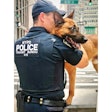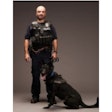Sgt. Robert Allen, weighed down in 50 pounds of tactical ballistic assault gear, has a reporter in his office, a lieutenant standing in the doorway, a ringing cell phone in one hand, and a three-wire mic at his left ear, listening to the Tucson Police Department SWAT team prepare for deployment.
And he's making it look easy.
"Yeah, we're still doing that warrant," Allen says into the phone, as the interview switches over to the lieutenant. "He's in Phoenix, but he should be back by 3 or so.... You wanna give him a call and ask him where he's at?"
Half an hour earlier, Tucson PD counter-narcotic agents and SWAT officers briefed on the operation's target: a local meth house. They familiarized themselves with the building layout and its occupants and sent out a surveillance/intelligence team. SWAT officers readied their assault vehicle, checked their weapons and explosive charges, and strapped on their woodland camouflage tactical gear. Several hours (and numerous bottles of Gatorade) later, the operation is called off. The suspect failed to show for a meeting with undercover officers.
It's an impressive demonstration of logistics-and a real-life example of the "hurry up and wait" nature of SWAT.
"It's a job where you have to really want to be here," Allen says. "Sometimes, there's a long time of waiting for something that most likely won't happen. But you're there to prevent it if it does."
The Tucson SWAT team has come a long way from very humble beginnings. Tucson PD formed its first tactical team in 1974 to keep pace with the city's violent, rapidly expanding marijuana and heroin trade. Back then, the team fielded eight police officers, mostly with military backgrounds, who trained on their own time and often deployed with their personally owned firearms.
"It had no budget, really," says Allen, a SWAT supervisor and 18-year veteran of the department. "Most of the guys made their own tac vests. They had some shotguns, some seized weapons. Some of the stuff was given by the military, back in the day."
Today, Tucson SWAT consists of 40 officers, four supervisors, and one lieutenant. Each team member also has a specialty assignment, as a sniper, tactical medic, chemical and less-lethal munitions expert, explosives breacher, or covert operator. Team members are also cross-trained in other specialty areas, including deployment of light-sound distraction devices (flash-bangs) and operation of armored personnel carrier rescue vehicles. SWAT officers train twice a month on department time and receive specialized training as needed.
All of that training and team building pays great dividends for the Tucson PD. The team is operationally deployed an average of 180 to 200 times for barricade incidents, high-risk arrests and warrant services, counter-sniper operations, hostage rescue, buy-bust narcotics operations, and active shootings. The team also assists with riot control and VIP protection details for visiting dignitaries.
Tucson is located less than an hour from the Mexican border, and the team has become especially adept at dealing with violence stemming from the international narcotics trade. The city is a major distribution point for cocaine, methamphetamine, and other drugs, and officers frequently encounter heavily armed security forces at local stash houses-as well as toxic/potentially explosive meth cookhouses, numerous narco-related kidnappings, and high-firepower rip-offs among rival drug organizations.
Since 1992, the year he joined the team, Allen has been on 700-plus SWAT deployments. A recent callout, which was resolved before the team arrived, involved a slow-speed, cross-town chase of a 40-ton construction earthmover with a disturbed 14-year-old boy at the controls.
"That's one thing about SWAT," Allen says. "We have to think about those 'what ifs,' and what we're going to do. They give us the job, and we're going to get the job done."
Officers must have three years of service with Tucson PD or another accredited law enforcement agency before becoming eligible to test for SWAT. In addition to successfully completing timed physical fitness obstacle courses, candidates must pass rigorous handgun and shotgun qualification tests, and undergo administration and peer reviews.
"You want someone who's self-motivated, self-initiated, a good person and a good officer," says Allen. "Someone who demonstrates leadership, integrity, and common sense. You can teach tactics; you can't teach common sense."
As Tucson continues to grow, so will the department's tactical team, predicts SWAT Commander Lt. Steve Mesich.
"It's going to be much larger," Mesich says. "There are currently discussions about increasing it by 10 bodies, to make it more commensurate with the size of the city and the department. Hopefully, at some point there will be enough support for a full-time component."
Bryn Bailer is a former newspaper reporter and a contributing editor for Police. She lives in Tucson, Ariz.













